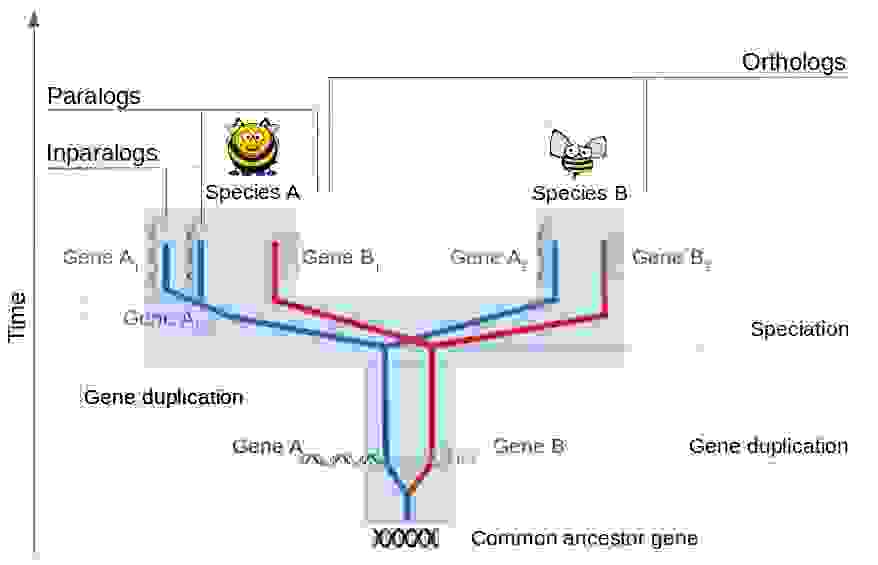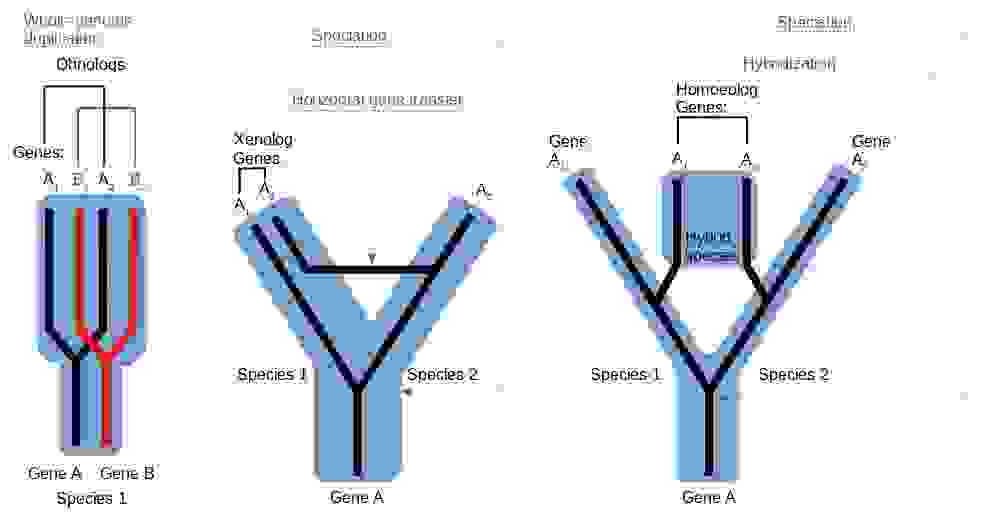What is Homology?
Objectives:
To gain a basic understanding of the concept of homology, similarity, and analogy. To recognize various types of homologies. To gain a basic understanding of various levels of homology and the concept of deep homology.
Table of contents
- What is Homology?
- What is Analogy?
- What are the Classes of Homology?
- What are the processes Resulting in Analogous genes?
- Reversals - Atavism
- Homology and Levels of Hierarchy
- GRN Kernels, Character Identity Networks (ChIN), and Deep Homology
- The kernel concept
- The character identity network (ChIN) concept
- The Deep Homology Concept
A widely accepted broad definition of homology within biological sciences is:
Things are homologs if they share a common ancestry.
Homology is a hierarchical concept, and therefore the "things" refer to different items at each level.
According to this definition, a "thing" either is a homolog to some other "thing," or it is not. There is no percentage nor degree of homology. "Things" can be similar to some degree, but there is no degree of homology. A living organism either shares a common ancestry or not. Like you and your sister, have the same father or mother, or you don't.
Also, homology is always a hypothesis based on a degree of similarity, because we don't know the specific historical events, that led to an observed similarity. For example, in the case of DNA or protein sequences, we only have the present-day sequences, apart from some discovered fragments of dinosaur DNA sequences.
In many scientific papers, there is a confusion between a degree of similarity and homology. Perhaps the ambiguity derives from the fact that the degree of similarity among organisms or components of organisms furnishes evidence for a hypothesis of homology.


What is Analogy?
Identical, alike, or corresponding genes, traits, or characteristics in organisms and don't have the same ancestral origin are analogous.
Homology and Analogy
Not all similarities mean that things are homologous. Structures may have separately evolved to become similar and have related functions. Alike, but not homologous structures are analogs and due to, for example, convergent evolution. For instance, Elvis and an Elvis impersonator are alike but do not have the same parents (Figure 1).
The similarity among structures may be due to 1. common ancestry, 2. convergent evolution, 3. parallel evolution, 4. reversals, or 5. unknown random events. The similarity of structures or functions caused by other reasons than common lineage is analogous (Figure 2).
Consequently, the degree of similarity is useful for hypothesis generation but not alone enough to define a homology. We discuss more this later.
This tutorial focuses on biological sequence similarity and homology. Biologists have given several different names to evolutionary processes and the products of these processes. Let's start by looking at the different classes of homology.


What are the Classes of Homology?
| Class | Description |
|---|---|
| Orthologs | Genes that diverged by speciation are orthologous. They may or may not have the same function. |
| Paralogs | Genes that originate from an ancestral duplication and reside within the same species are paralogous. |
| In-paralogs or symparalogs | A subtype of paralogs. Genes that have duplicated after the last speciation event are in-paralogs. |
| Out-paralogs or alloparalogs | A subtype of paralogs. These are genes that duplicated before the latest speciation event. |
| Ohnologs | A subtype of paralogs. A whole-genome duplication results in ohnologous genes. They have a common origin and have diverged an identical length of time. |
| Gametologs | The genes in sex chromosomes that have not recombined. |
| Xenologs | A transfer of genes, by means other than direct decent from parents to offsprings from one organism to another, results in xenologous genes. |
| Homoeologs | A subtype of xenologs. The hybridization of genes from two separate species produces Homoeologous genes. |
Browse and search The National Center for Biomedical Ontology
Orthologs
Orthologous genes are genes that have diverged after a speciation event and are thus residing in different species. Often many people use the term ortholog to mean that they are functionally equivalent homologs. However, it is evolutionarily incorrect even, though orthologs in many cases may have similar or identical functions. Examples of orthologs are beta hemoglobin genes of humans and chimpanzees.
Multiple genes can be orthologous with each other at the same time. In Figure 3, B1 - B2, A1 - A2, and A1b - A2 are orthologous genes. The genes A1 and A1b are co-orthologous with A2.
Orthologs are useful in the construction of phylogenetic trees, comparison of the evolution of genomes, and give information for classification of organisms (Figure 3).
Paralogs
These are the genes that have duplicated before or after speciation and remain within the same species. Paralogous genes are interesting for the study of protein evolution. For example, the four classes of hemoglobin genes, hemoglobin A, hemoglobin A2, hemoglobin B, and hemoglobin F, are paralogs.
In-paralogs (symparalogs)
An additional classification of paralogs. Genes that have duplicated after the last speciation event are inparalogs. In Figure 3, A1 - A1b are in-paralogs. Species B has no in-paralogs (Figure 3).
Out-paralogs (alloparalogs)
The second additional classification of paralogs. These are genes that duplicated before the latest speciation event. In Figure 3, A1 - B1 and A1b - B1 are out-paralogs, and in species B, A2 - B2 are also out-paralogs.
Ohnologs
The third subtype of paralogs. These are genes that are a result of a duplication of a whole genome (Figure 4).
Gametologs
A comparatively new class of homologs, coined by Jaime García-Moreno and David P. Mindell in 2000. These are the genes in sex chromosomes that have not recombined. Though, according to recent studies, gene conversion may result in some restricted exchange of information between gametologs.
Xenologs and Lateral gene Transfer
A transfer of genes from one organism to another, unrelated, organism results in xenologous genes. This process is known as lateral gene transfer and also as horizontal gene transfer. Lateral gene transfer can occur among unrelated organisms, differing from the vertical gene transfer in which gene transfer is from parents to offsprings (Figure 4).
Notably, bacteria transfer genetic material among themselves to gain antibiotic resistance or virulence. Lateral gene transfer is the major contributor to disease outbreaks and the rise of hyper-virulent human pathogens.
However, lateral gene transfer is not limited to bacteria. It can occur between, and among, various organisms. For example, bacteria to fungi, plants, insects, and animals, plant to plant, plants to animals, fungi to insects, are a few known cases, but there are many other.
Homoeologs
The hybridization of genes from two separate species produces Homoeologous genes (Figure 4). These are genes that a speciation event has separated. When hybridized together, they are homoeologs.




On the next page, we begin by describing the processes that result in analogous genes.
You may also be interested in the following
Related tutorials
Pair-wise sequence alignment
Pair-wise sequence alignment methods
How to select the right substitution matrix?